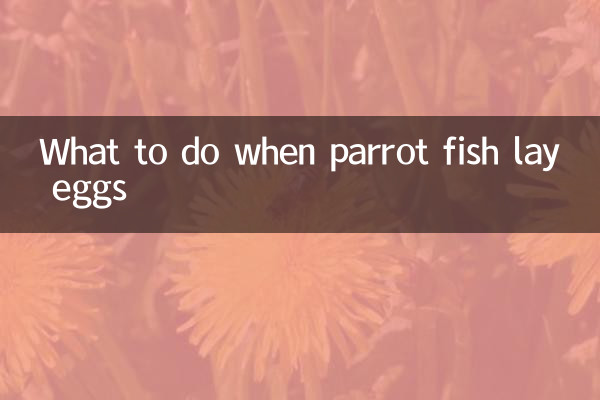What to do when parrot fish lay eggs
In recent years, parrot fish have become a popular choice among aquarium enthusiasts due to their bright colors and unique shapes. However, when parrot fish enter the breeding season and begin laying eggs, many keepers may feel at a loss. This article will explain in detail the response measures for parrot fish spawning, and provide structured data to help you better manage this process.
1. Signs of parrot fish spawning

Parrot fish usually show some obvious signs before spawning, and keepers can prepare in advance by observing these behaviors:
| sign | Specific performance |
|---|---|
| Increased territorial behavior | Parrot fish will frequently drive away other fish to protect their spawning areas. |
| cleaning behavior | Female fish will use their mouths to clean the surface on which they lay their eggs (such as tank walls, rocks, etc.). |
| distended abdomen | The abdomen of the female fish will be significantly enlarged and the body color may be brighter. |
| decreased appetite | 1-2 days before spawning, the appetite of parrot fish will decrease significantly. |
2. Treatment steps after parrot fish spawns
When it is discovered that parrot fish have laid eggs, the breeder needs to take the following measures to ensure the safety and healthy hatching of the eggs:
| step | Specific operations |
|---|---|
| Isolate broodstock | Separate the broodstock from the eggs after spawning to prevent them from swallowing the eggs. |
| Keep water quality stable | The water temperature is controlled at 26-28°C, and the pH value is maintained between 6.5-7.5. |
| oxygenate | Use an air pump to increase the amount of dissolved oxygen in the water to ensure normal development of fish eggs. |
| Avoid direct sunlight | Fish eggs are sensitive to strong light and need to be placed in an environment with soft light. |
3. Fish egg hatching and juvenile fish management
Parrot fish eggs usually take 2-3 days to hatch. During this period, keepers need to observe closely and do the following:
| time | Things to note |
|---|---|
| Incubation period (1-3 days) | Keep the water clean and avoid moldy fish eggs. |
| After juvenile fish break eggs (3-5 days) | Young fish rely on their yolk sacs to survive and do not require feeding. |
| Juvenile fish swimming period (5-7 days) | You can start feeding water or ultra-fine particle feed. |
| Growth period (after 7 days) | Gradually increase the amount of feeding and change the water regularly. |
4. Frequently Asked Questions
1.What should I do if my parrot fish eggs turn white?
White fish eggs are usually unfertilized or dead and need to be removed with a straw in time to avoid contaminating the water quality.
2.Is it necessary to intervene if the broodstock has been guarding the eggs?
If the parent fish shows strong egg-protecting behavior, it may not be isolated temporarily, but it needs to be closely observed to see if it swallows fish eggs.
3.How to solve the high mortality rate of juvenile fish?
Young fish are sensitive to changes in water quality. It is recommended to raise them individually in small tanks and keep the water temperature and pH value stable.
5. Summary
Parrot fish spawning can be a challenge, but it can also be a lot of fun. Through scientific observation and careful management, you can successfully hatch and grow healthy parrot fish larvae. Remember, stable water quality and proper nutrition are the keys to success!

check the details

check the details